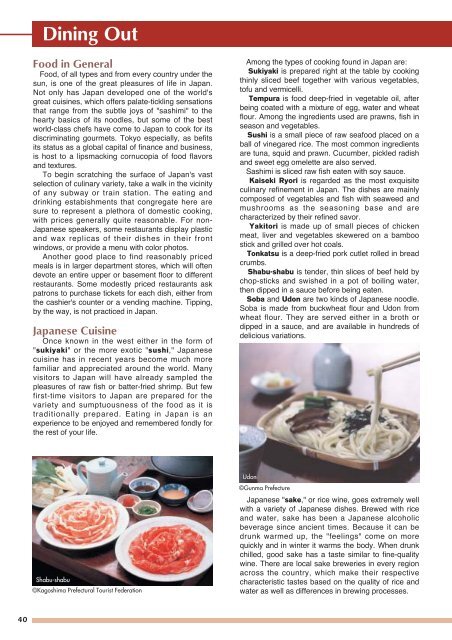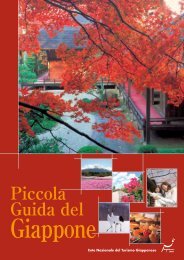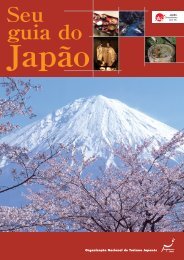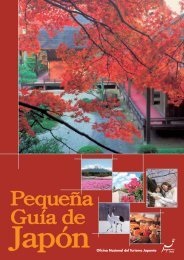Your Guide to - Japan National Tourist Organization
Your Guide to - Japan National Tourist Organization
Your Guide to - Japan National Tourist Organization
You also want an ePaper? Increase the reach of your titles
YUMPU automatically turns print PDFs into web optimized ePapers that Google loves.
40<br />
Dining Out<br />
Food in General<br />
Food, of all types and from every country under the<br />
sun, is one of the great pleasures of life in <strong>Japan</strong>.<br />
Not only has <strong>Japan</strong> developed one of the world's<br />
great cuisines, which offers palate-tickling sensations<br />
that range from the subtle joys of "sashimi" <strong>to</strong> the<br />
hearty basics of its noodles, but some of the best<br />
world-class chefs have come <strong>to</strong> <strong>Japan</strong> <strong>to</strong> cook for its<br />
discriminating gourmets. Tokyo especially, as befits<br />
its status as a global capital of finance and business,<br />
is host <strong>to</strong> a lipsmacking cornucopia of food flavors<br />
and textures.<br />
To begin scratching the surface of <strong>Japan</strong>'s vast<br />
selection of culinary variety, take a walk in the vicinity<br />
of any subway or train station. The eating and<br />
drinking estabishments that congregate here are<br />
sure <strong>to</strong> represent a plethora of domestic cooking,<br />
with prices generally quite reasonable. For non-<br />
<strong>Japan</strong>ese speakers, some restaurants display plastic<br />
and wax replicas of their dishes in their front<br />
windows, or provide a menu with color pho<strong>to</strong>s.<br />
Another good place <strong>to</strong> find reasonably priced<br />
meals is in larger department s<strong>to</strong>res, which will often<br />
devote an entire upper or basement floor <strong>to</strong> different<br />
restaurants. Some modestly priced restaurants ask<br />
patrons <strong>to</strong> purchase tickets for each dish, either from<br />
the cashier's counter or a vending machine. Tipping,<br />
by the way, is not practiced in <strong>Japan</strong>.<br />
<strong>Japan</strong>ese Cuisine<br />
Once known in the west either in the form of<br />
"sukiyaki" or the more exotic "sushi," <strong>Japan</strong>ese<br />
cuisine has in recent years become much more<br />
familiar and appreciated around the world. Many<br />
visi<strong>to</strong>rs <strong>to</strong> <strong>Japan</strong> will have already sampled the<br />
pleasures of raw fish or batter-fried shrimp. But few<br />
first-time visi<strong>to</strong>rs <strong>to</strong> <strong>Japan</strong> are prepared for the<br />
variety and sumptuousness of the food as it is<br />
traditionally prepared. Eating in <strong>Japan</strong> is an<br />
experience <strong>to</strong> be enjoyed and remembered fondly for<br />
the rest of your life.<br />
Shabu-shabu<br />
©Kagoshima Prefectural <strong>Tourist</strong> Federation<br />
Among the types of cooking found in <strong>Japan</strong> are:<br />
Sukiyaki is prepared right at the table by cooking<br />
thinly sliced beef <strong>to</strong>gether with various vegetables,<br />
<strong>to</strong>fu and vermicelli.<br />
Tempura is food deep-fried in vegetable oil, after<br />
being coated with a mixture of egg, water and wheat<br />
flour. Among the ingredients used are prawns, fish in<br />
season and vegetables.<br />
Sushi is a small piece of raw seafood placed on a<br />
ball of vinegared rice. The most common ingredients<br />
are tuna, squid and prawn. Cucumber, pickled radish<br />
and sweet egg omelette are also served.<br />
Sashimi is sliced raw fish eaten with soy sauce.<br />
Kaiseki Ryori is regarded as the most exquisite<br />
culinary refinement in <strong>Japan</strong>. The dishes are mainly<br />
composed of vegetables and fish with seaweed and<br />
mushrooms as the seasoning base and are<br />
characterized by their refined savor.<br />
Yaki<strong>to</strong>ri is made up of small pieces of chicken<br />
meat, liver and vegetables skewered on a bamboo<br />
stick and grilled over hot coals.<br />
Tonkatsu is a deep-fried pork cutlet rolled in bread<br />
crumbs.<br />
Shabu-shabu is tender, thin slices of beef held by<br />
chop-sticks and swished in a pot of boiling water,<br />
then dipped in a sauce before being eaten.<br />
Soba and Udon are two kinds of <strong>Japan</strong>ese noodle.<br />
Soba is made from buckwheat flour and Udon from<br />
wheat flour. They are served either in a broth or<br />
dipped in a sauce, and are available in hundreds of<br />
delicious variations.<br />
Udon<br />
©Gunma Prefecture<br />
<strong>Japan</strong>ese "sake," or rice wine, goes extremely well<br />
with a variety of <strong>Japan</strong>ese dishes. Brewed with rice<br />
and water, sake has been a <strong>Japan</strong>ese alcoholic<br />
beverage since ancient times. Because it can be<br />
drunk warmed up, the "feelings" come on more<br />
quickly and in winter it warms the body. When drunk<br />
chilled, good sake has a taste similar <strong>to</strong> fine-quality<br />
wine. There are local sake breweries in every region<br />
across the country, which make their respective<br />
characteristic tastes based on the quality of rice and<br />
water as well as differences in brewing processes.

















